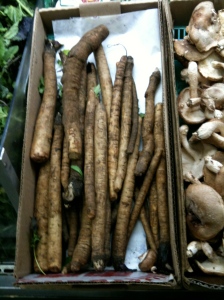What's Burdock?
I was in my local food store, Guido’s, in the Berkshires yesterday and came across a root vegetable I was unfamiliar with — burdock.


I was curious about the root so I did a little research. Here’s some info from Wikipedia:
The taproot of young burdock plants can be harvested and eaten as a root vegetable. While generally out of favour in modern European cuisine, it remains popular in Asia, particularly in Japan where A. lappa (Greater burdock) is called gobŠ(牛蒡 or ゴボウ). Plants are cultivated for their slender roots, which can grow about 1 metre long and 2 cm across. Burdock root is very crisp and has a sweet, mild, and pungent flavour with a little muddy harshness that can be reduced by soaking julienne/shredded roots in water for five to ten minutes. Immature flower stalks may also be harvested in late spring, before flowers appear; the taste resembles that of artichoke, to which the burdock is related. A popular Japanese dish is kinpira gobŠ(金平牛蒡), julienned or shredded burdock root and carrot, braised with soy sauce, sugar, mirin and/or sake, and sesame oil; another is burdock makizushi (sushi filled with pickled burdock root; the burdock root is often artificially coloured orange to resemble a carrot). In the second half of the 20th century, burdock achieved international recognition for its culinary use due to the increasing popularity of the macrobiotic diet, which advocates its consumption. It also contains a fair amount of gobŠdietary fiber (GDF, 6g per 100g), calcium, potassium, amino acids,[3] and is also low calorie. It also contains polyphenols that causes darkened surface and muddy harshness by formation of tannin-iron complexes though the harshness shows excellent harmonization with pork in miso soup (tonjiru) and Japanese-style pilaf (takikomi gohan).